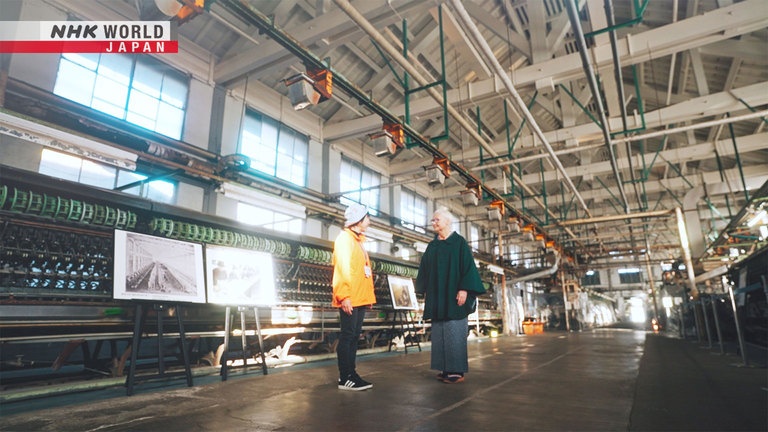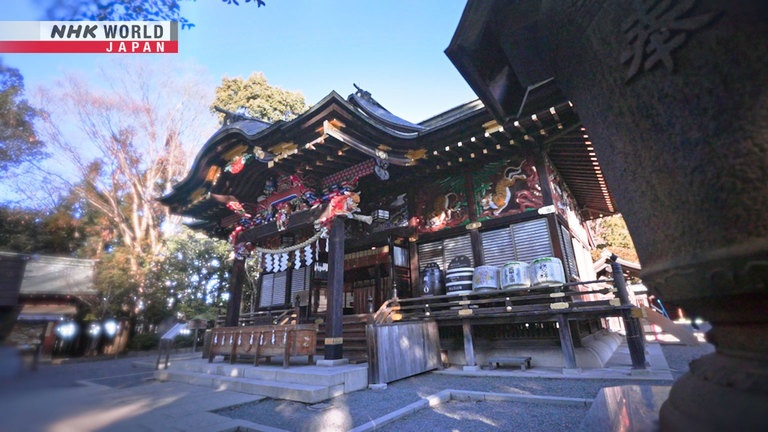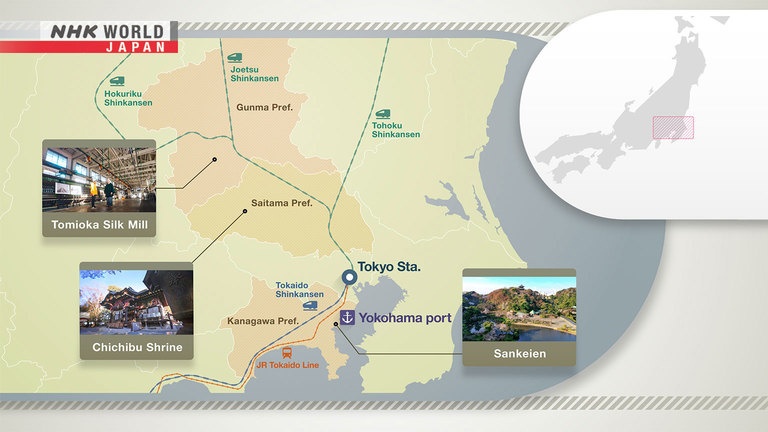SILK Road: Threads of History from Gunma to Yokohama
In 1859, when Japan reopened its doors after more than two centuries of isolation, goods flowed in and out of newly expanded ports. At the time, raw silk became the country's largest export, as the silk industries in France and Italy had been hit by an epidemic of silkworm disease. At one point, Japan was the world's biggest exporter. On this episode of Journeys in Japan, Sheila Cliffe from the UK follows the Silk Road from northern Kanto, once a major production area, to Yokohama, where the silk took off to the world.
Tomioka Silk Mill

Japan's first government-operated mechanized silk mill was established in 1872 in Tomioka City, Gunma Prefecture. The World Heritage Site is open to the public.
Chichibu Shrine

The shrine has deep ties to the silk industry. Once a year, silkworm farmers make offerings of cocoons to express their gratitude.
Sankeien Garden

The formal Japanese garden was built by the entrepreneur Hara Sankei, who made his fortune in the silk trade. He relocated significant buildings and art to the sprawling site.
Access

To reach the Tomioka Silk Mill from Tokyo, it takes about one hour and forty minutes by Shinkansen to Takasaki with a transfer to a local line. Chichibu is about an hour from Tokyo's Ikebukuro. Trains from Tokyo to Yokohama take around thirty minutes.
Transcript
"Journeys in Japan"
A pure luster.
Irresistibly smooth to the touch.
Raw silk.
Its allure is enduring.
The exquisite silk of Japan unfurled onto the world stage.
A natural phenomenon enhanced by artisans' innovation.
SILK Road:Threads of History from Gunma to Yokohama
On "Journeys in Japan," Sheila Cliffe
traces the country's modern-day Silk Road.
Japan has a very long history with silk.
In ancient times,
unlike cotton and linen,
silk was used for the kimono of those from higher status.
But I've learned that, in more recent history,
silk was much more than just material for clothing.
It has had a huge impact on Japanese society.
This journey starts in Gunma Prefecture,
once a major silk production area,
and it ends in Yokohama,
where the silk was gathered for trade and export.
The gateway was Tomioka,
where silkworms were harvested for threads.
Textiles made nearby were mostly destined for Yokohama's port,
and the world beyond.
Sheila Cliffe is a kimono researcher from the UK.
(Tomioka city, Gunma prefecture)
Established in 1872,
the Tomioka Silk Mill was Japan's first government-operated raw silk factory.
It's designated as a World Heritage Site.
Hello.
Hello, nice to meet you.
I will guide you around. Please come this way.
(Silk reeling plant)
Silk strands were extracted from cocoons and spun into raw silk thread here.
This mill is huge. And it's bright with all the big windows.
There was no electricity at that time, so the natural light was essential.
The artisans needed it to see the threads clearly.
The artisans carefully removed impurities to soften and even out the threads.
At the turn of the 20th century,
the Tomioka Silk Mill was the world's largest complex.
And in 1909, that propelled Japan
to the position of top raw silk exporter in the world.
But over time, other markets in the world offered raw silk at lower prices,
and the Tomioka Silk Mill ended operations in 1987.
One mill still preserves its machinery from back in the day.
(Annaka city, Gunma prefecture)
Only two large-scale mechanized silk mills exist in Japan today.
One in Yamagata and our Usui-seishi.
These are dried silk cocoons.
Silkworms spin cocoons in the process of pupation.
Silk threads are a naturally unraveled material.
Are there different species of silkworms?
Yes. Some were developed in the Meiji period.
We have thin and yellow types.
We produce various threads from about ten different kinds of cocoons.
(sorting)
After sorting, the removed cocoons are used for
stuffing and the pupae for fish food.
We waste nothing from the silkworms that have given their lives.
This is our silk-reeling plant.
Cocoons are boiled until they're sufficiently soft to extract the filaments.
The end of the strand is pulled out from the boiled cocoons.
Then, the strand is spun into raw silk thread.
This thread then becomes kimono, right?
Yes. The strand is very delicate and fine,
about one-twentieth as fine as a strand of hair.
This machine looks like the ones in Tomioka.
This is the same model as those in the Tomioka Silk Mill.
Some people who visit the Tomioka mill also visit us
to see the machines actually working.
Before shipping, we conduct the final finishing process here.
It is so beautiful.
As for the cocoons processed here, are they all raised in Japan?
We purchase about 70 percent of the cocoons grown in Japan.
So, we are the largest silk mill that produces wholly made-in-Japan raw silk.
Without your mill, the silk industry in Japan would vanish.
Yes. Our mission is to continue to produce
100 percent made-in-Japan raw silk from domestic cocoons.
By doing so, we would like to protect Japan's silk industry.
(Isesaki city, Gunma prefecture)
Hello.
This building is so large.
This house had a space for silkworm breeding and eggs.
The architecture is distinctive for...
its extra attic space.
This style became popular in the area about 160 years ago.
Silkworms were raised on the entire second floor.
People lived on the first floor,
and cultivated their silkworms on the second.
This straw structure is a "mabushi."
When a silkworm matures it spins a cocoon.
A silk moth emerges 15 days later.
A silk moth lays over 300 eggs.
More than 8,000 eggs are attached to this sheet.
These "egg cards" were shipped within Japan and overseas.
The home features large windows upstairs that provide adequate ventilation...
and good air circulation even above the second floor.
With ideal temperature, humidity and ventilation,
the architecture supported a silkworm-friendly environment.
Construction of these buildings was really clever and well thought out
in to how to make silk farming more efficient and effective
both in quality and quantity of silkworms.
How was the silk transported great distances?
Usui 3rd Bridge (Megane-bashi)
This is the Megane-bashi "spectacles" viaduct.
This viaduct was built for a railway.
In addition to passengers, it carried raw silk and cocoons.
Japan's emerging rail systems at the time helped the silk industry flourish.
The former railway site and viaduct,
designated as a National Important Cultural Property, are now a footpath.
Before the construction of the railway,
they had to be carried by road or by river.
Either way, the destination was Yokohama.
(Chichibu city, Saitama prefecture)
Chichibu is another town that thrived on raw silk production.
A culture of kimono blossomed in this area.
This is a Chichibu Meisen studio.
Chichibu Meisen is a local silk textile that dates to the Meiji period.
It was hugely popular for its vivid colors and complex patterns.
This is the first process of weaving Chichibu Meisen.
First, the weft thread is loosely woven
through the white silk warp thread like drawing Z.
Then, the woven fabric is taken to the dyeing area.
A stencil with a pattern is placed over the warp threads,
and dye is applied.
This is repeated several times.
What are you doing here?
I'm loosening the warp thread.
After that, we do the final weaving.
Chichibu Meisen was one of the first mass-produced silk kimono in Japan.
It has beautiful shine, and it's so colorful,
and people love the new and modern fashionable designs.
I love it too.
The area is home to another handwoven silk fabric.
The cocoons are boiled and made into thread straight away?
Yes.
Wow, amazing.
What kind of fabric is woven with this thread?
This thread is for Futori fabric.
Silk farmers used to make raw silk thread
from unsaleable cocoons to weave textiles at home.
The textile was used for workwear and everyday clothes.
This thread has undergone the scouring process.
It is soft and feels great. It has a beautiful sheen, too.
All were naturally dyed. This one with walnuts.
Walnuts? The color is appealing, beautiful.
The thread is naturally fuzzy from the silkworms' spinning.
That is why the fabric is fluffy.
Chichibu Futori is known for its distinctive texture
born from the untwisted threads.
Here it is.
It is thicker than it looks.
And it has a warmth and is fluffy. It's lovely.
The technique of Chichibu Futori once disappeared.
But Wada Toshiko's father revived it.
When I was young, I was not interested in my father's work.
But, about 30 years ago, he made me a scarf, which I loved.
That's what inspired me to learn the art of Chichibu Futori.
Chichibu Shrine was founded around 2,100 years ago.
Since Chichibu once thrived on silk farming,
people offer silk cocoons to the shrine once a year.
Chichibu Meisen has brilliant colors and patterns.
Chichibu Futori is the origin of Chichibu Meisen.
On her journey along the Silk Road,
Sheila encounters two kimono with a "woven" history.
While raw silk was exported, cotton thread was imported.
Kawagoe has retained its Edo period ambience.
The old merchant town is even nicknamed "Koedo," or little Edo.
This is it.
Kawagoe Tozan cotton weaving.
It has a nice, fine stripe.
And when you touch it, it feels like silk.
- It feels really soft and smooth.
- Thank you.
Kawagoe Tozan is woven with smooth double-twisted cotton.
The fabric has a unique silky touch.
The history of Kawagoe Tozan goes back to the end of the Edo period,
when fine cotton thread began to be imported at low cost.
Western ships, which docked at Yokohama to take home silk,
brought with them fine cotton thread, not available in Japan at the time.
As ordinary people could not afford silk,
they enjoyed Kawagoe Tozan, which had a silky touch.
By the way, Kasama-san, what about the matter we discussed?
Oh, yes, your order.
I wanted you to check it. So shall we go to the atelier?
I am excited.
Kawagoe Tozan relied solely on hand-weaving,
so the technique once disappeared amid the growing mechanization of weaving.
People in Kawagoe revived the technique.
However, weaving it is tough work, as the threads are very thin.
It's wonderful.
This is the Kawagoe Tozan you designed. What do you think?
It's wonderful.
Your design had beautiful vivid colors.
It was a little hard to produce each color clearly.
However, we managed to do that by adding greenish yellow weft thread.
I can't wait to wear it.
(Yokohama Port)
In the Edo period,
Japan closed its borders and restricted international trade
for over 200 years.
But in 1859 it opened several ports, including Yokohama's.
The raw silk collected from Gunma and other locales
was brokered to foreign merchants.
Hello.
Tell me about this place.
It was a wharf. Because of its shape,
it is called Zou-no-hana or the trunk of an elephant.
How is it related to silk?
When the Yokohama Port was opened,
raw silk was loaded into small ships here
and then transferred to big cargo ships offshore.
Why did Western countries buy such large amounts of Japan's raw silk?
Around the time when this port opened,
silkworm populations in Europe had been destroyed by disease.
And in the 1880s, after America's Civil War,
women began to wear silk dresses.
Japanese raw silk sold briskly.
And in 1909, Japan became the largest silk exporter.
Can we find traces of those days in Yokohama?
Well, there are only a reproduced raw silk inspection center
and a raw silk exchange.
But Sheila, let me show you something. Please follow me.
This is the Ooka River.
After the "nassen" process,
textiles were washed in this river to remove excess glue or dye.
Nassen is a dyeing technique that uses stencils.
When the Yokohama port opened,
ukiyo-e woodblock printing artisans relocated to the area.
And they used their craft on textiles.
Some also embraced Western printing techniques.
He is making a screen. It is like woodblock printing.
The screen is burned like a cyanotype,
so that the glue is not applied to the parts exposed to light.
When the screen is rinsed, you can see where the glue was applied.
Is it done?
Not yet.
We have another 13 colors. After test printing, we print the silk fabric.
I wonder what it is? It's too big for a handkerchief.
This is the finished product.
It's a scarf.
Yes, it is called a Yokohama scarf. This is what I am working on.
It's a signature silk product of Yokohama
that's been exported since the 1930s.
These scarves have been popular for their colors and sophisticated designs.
The Yokohama scarf carries the history and craftsmanship of Yokohama,
which was once the center of silk trading.
- Hello.
- Hello.
This is the Sankeien.
It was designed and built by Hara Sankei,
who also operated the Tomioka Silk Mill.
This formal garden from 1906 covers about 180,000 square meters.
Its founder, Hara Sankei, was a successful businessman
who engaged in the raw silk trade.
In fact, he also operated the Tomioka Silk Mill for 36 years.
There are so many old buildings.
Hara Sankei relocated them from Kyoto, Kamakura, and other places.
Amid modernization in the Meiji period,
temples and other traditional buildings were abandoned.
Hara relocated significant structures here.
Hara Sankei created this work.
They are silkworms.
Hara Sankei preserved not only old buildings,
but also antiques. He also supported young artists.
Japan was pushing rapid modernization to catch up with the West,
and many elites were eschewing traditional aesthetics
for European trends.
But not Hara Sankei.
He was devoted to preserving Japan's cultural legacies in his Sankeien.
He had a passion for passing on Japanese culture to the next generation.
That's why he opened this place to the public.
Sankeien still plays a role to pass on Japanese culture.
So, raw silk helped preserve Japanese culture and tradition in various ways.
Exactly.
This concludes our journey on the Silk Road of Japan.
I've learned how deeply embedded silk is with Japanese society.
It was a great force for modernization,
but historically, it has deep ties with Japanese culture.
I was impressed with those who work to keep Japan's silk culture alive,
and fascinated by the precision required in making kimono.
But this program was about more than just silk for wearing.
It was a great opportunity
to learn about the deep meaning of silk for Japan.
From Tokyo to the Tomioka Silk Mill,
take the Shinkansen to Takasaki,
and then transfer to a local train.
It takes about 1 hour and 40 minutes in total.
From Tokyo to Yokohama Port,
it takes about 30 minutes by local train.